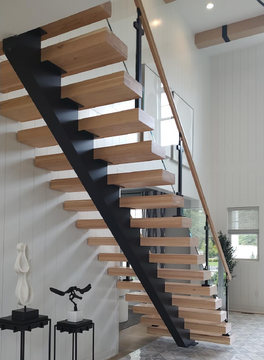Can Horizontal Rods be used outside?
Posted by Railing Pro on Feb 1st 2025
Horizontal rods have surged in popularity as a stylish and modern alternative to traditional balusters in railing systems. Their clean, linear design offers an unobstructed view, complements various architectural styles, and adds a touch of contemporary elegance to any space. But can these sleek horizontal bars stand up to the rigors of outdoor environments?
Yes! Horizontal rods can be used outdoors, but there are crucial factors to consider when selecting the right materials, finishes, and installation methods to ensure durability and weather resistance. This comprehensive guide will explore the best practices for using horizontal rods in exterior railing systems, comparing material options, offering installation tips, and highlighting trusted products from DeckPro and Fortress.
Choosing the Right Material for Exterior Horizontal Rods
Selecting the appropriate material is paramount when using horizontal rods outdoors. The choice between interior-grade steel and exterior-grade aluminum can significantly impact the longevity and performance of your railing system.
Interior vs. Exterior Rods: A Detailed Comparison
Interior Rods:
- Material: Typically made of powder-coated 5/8" diameter round steel with a 1mm wall thickness.
- Lengths: Available in 6-foot and 8-foot lengths.
- Corrosion Resistance: Designed primarily for indoor use, these rods are not inherently weather-resistant. However, with proper sealing, they can be used outdoors.
- Installation: Requires meticulous sealing at the ends with a high-quality polyurethane adhesive (such as Loctite PL) to prevent moisture from penetrating the steel and causing rust.
- Cost: Generally more affordable than exterior-grade options.
- Aesthetic: Often feature a sleek, minimalist look that complements modern interiors.
- Shop Interior Horizontal Rods: Shop Interior Horizontal Rods
Exterior Rods:
- Material: Typically made of aluminum with a specialized moisture-inhibiting coating inside.
- Lengths: Typically available in 6-foot lengths.
- Corrosion Resistance: Specifically engineered for outdoor use, aluminum rods offer superior corrosion resistance and longevity in harsh weather conditions.
- Installation: Requires fewer precautions than steel rods, though proper sealing is still recommended for added protection.
- Cost: More expensive than interior-grade steel but offers greater peace of mind for outdoor applications.
- Aesthetic: Available in a range of colors and finishes to complement outdoor spaces.
- Shop Exterior Horizontal Rods: Explore our collection of exterior horizontal railing systems, including DeckPro and Fortress options: Shop Horizontal Railing
Key Differences at a Glance
|
Feature
|
Interior Rods (Steel)
|
Exterior Rods (Aluminum)
|
| Material |
Powder-coated steel |
Aluminum with moisture-inhibiting coating |
|
Weather Resistance |
Requires sealing to prevent rust |
Naturally corrosion-resistant |
| Maintenance |
More frequent inspections and potential resealing |
Minimal maintenance |
| Cost |
Lower upfront cost |
Higher upfront cost, lower long-term maintenance expenses |
| Installation |
More meticulous sealing process |
Simplified installation with fewer precautions |
Installation Considerations for Outdoor Horizontal Rods
Proper installation is critical to ensure the safety, stability, and longevity of outdoor horizontal rod railing systems. Key considerations include post spacing, handrail height, and secure fastening methods.
Post Spacing for Stability
Manufacturers generally recommend a 4-foot post spacing to minimize flexing when lateral pressure is applied. This spacing ensures that the horizontal rods remain taut and provide a secure barrier, even when subjected to wind, impact, or leaning.
Standard Handrail Heights & Rod Requirements
- Residential Applications: Most standard handrails are 36 inches in height.
- Level Railings: Typically require 8 rods per section to comply with safety codes and prevent gaps that could pose a hazard.
- Staircases (Angled Pitch): Usually require 7 rods per section to account for the angled pitch while maintaining adequate safety.
- Commercial Applications: Check local and national building codes, as requirements vary by location.
Installation Tips
- Measure Accurately: Precise measurements ensure proper rod spacing and alignment.
- Use High-Quality Hardware: Stainless steel fasteners and connectors provide maximum corrosion resistance.
- Seal All Connections: Apply a weatherproof sealant to all joints and connections to prevent moisture intrusion.
- Tension Cables Properly: Ensure that the horizontal rods are properly tensioned to prevent sagging and maintain a secure barrier.
- Follow Manufacturer's Instructions: Adhere to the manufacturer's guidelines for post spacing, rod spacing, and installation techniques.
Weather Resistance & Maintenance
Choosing corrosion-resistant materials and implementing proper maintenance practices are essential for ensuring the longevity and aesthetic appeal of outdoor horizontal rod railing systems.
Material Selection
- Aluminum: Known for its natural resistance to rust and corrosion, making it an ideal choice for outdoor applications.
- Stainless Steel: Offers excellent corrosion resistance and strength, but can be more expensive than aluminum.
Finishes & Coatings
- Powder Coating: Provides a durable, weather-resistant finish that protects against scratches, fading, and corrosion.
- Anodizing: Enhances the corrosion resistance and durability of aluminum surfaces.
Maintenance Tips
- Regular Cleaning: Periodically clean the horizontal rods and posts with mild soap and water to remove dirt, debris, and grime.
- Inspect Regularly: Check for signs of corrosion, loose connections, or damage, and address any issues promptly.
- Apply Protective Coatings: Reapply protective coatings or sealants as needed to maintain weather resistance and prevent corrosion.
For more insights into best practices for outdoor metal durability, consult resources from the American Galvanizers Association.
Top Brands: DeckPro and Fortress
When it comes to horizontal railing systems, DeckPro and Fortress stand out as industry leaders, known for their quality, innovation, and reliability.
DeckPro
DeckPro is renowned for its user-friendly horizontal railing systems that combine style, durability, and ease of installation. Their horizontal aluminum railings are designed specifically for outdoor use, offering superior corrosion resistance and minimal maintenance.
Key Features of DeckPro:
- High-Quality Aluminum Construction: Provides excellent corrosion resistance and longevity.
- Powder-Coated Finish: Offers a durable, weather-resistant finish in a range of colors.
- Easy Installation: Designed for straightforward installation with pre-engineered components.
- Minimal Maintenance: Requires only occasional cleaning to maintain its appearance.
- Sleek, Modern Design: Complements a variety of architectural styles.
Fortress
Fortress is a leading provider of high-performance railing solutions, including their innovative Fortress Fe26 Axis horizontal railing system. Fortress products are known for their strength, durability, and stylish designs, making them a top choice for discerning homeowners and contractors.
Key Features of Fortress Fe26 Axis:
- Pre-Welded Panels: Streamline the installation process and ensure consistent quality.
- E-Coat and Powder-Coat Finish: Provides superior corrosion resistance and durability.
- Minimalist Design: Offers a clean, modern aesthetic with hidden fasteners.
- Code Compliance: Engineered to meet or exceed building code requirements.
- Wide Range of Styles and Colors: Available in a variety of styles and colors to suit any project.
Additional Tips
- Make sure to measure the width of the post and the total length of the railing before cutting. This will ensure that you have the correct number of horizontal rods.
- Pre-drill pilot holes before screwing in the horizontal rods. This will prevent the horizontal rods from splitting or cracking.
- Use a level to make sure that the horizontal rods are level before fastening them in place. This will help to ensure that the railing looks its best.
- Regularly inspect the railing for any signs of damage. If you find any damage, repair it immediately.
- When using multiple horizontal rods, spacing them according to code will guarantee a safe design.
Get Inspired: Explore Design Ideas
Looking for inspiration? Pinterest is a fantastic platform to discover modern railing solutions, see real-life installations, and spark your creativity.
Visit our Pinterest page for project galleries, before-and-after photos, and design tips.
Conclusion
Horizontal rods offer a stylish and durable option for outdoor railing systems when the right materials and installation methods are used. For maximum weather resistance, opt for exterior-grade aluminum rods with an internal coating and properly seal any steel rods if used outside. By choosing DeckPro or Fortress horizontal railing systems, you can ensure a safe, stylish, and long-lasting outdoor railing solution.
Looking for high-quality horizontal railing rods for your project? Explore our selection today!
Explore Railing Pro's Horizontal Railing Options
Further Reading & Resources:
- Horizontal Bars
- DeckPro Horizontal Railing Systems
- Fortress Fe26 Axis Horizontal Railing Systems
- American Galvanizers Association
Elevate your outdoor space with the strength, beauty, and transparency of horizontal rod railings from Railing Pro—the trusted choice for modern living.











